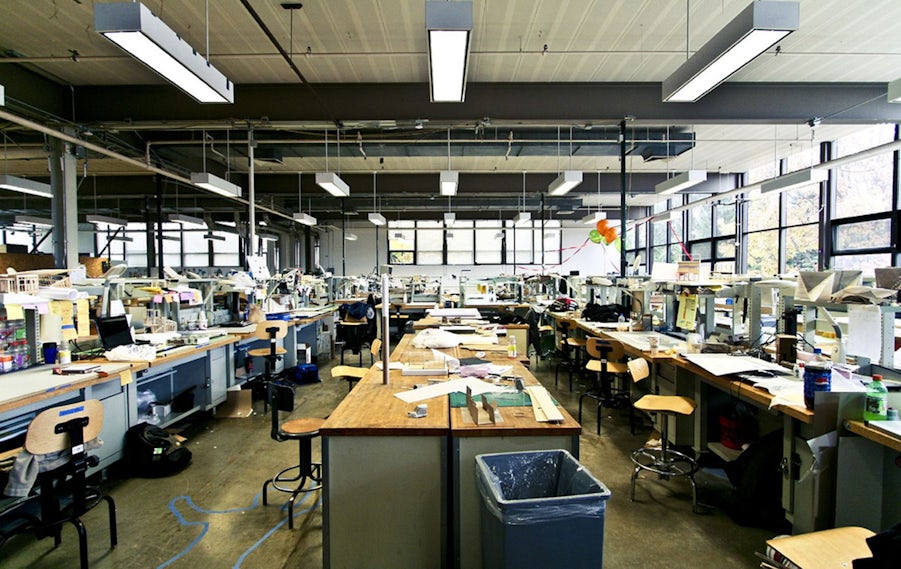Architects: Showcase your next project through Architizer and sign up for our inspirational newsletter.
Architectural education varies widely across the world in terms of focus, emphasis and outlook, but one thing nearly all architecture programs have in common is their format. Universal to the experience of architecture school is a dependence on individually oriented, open-ended design studios at the core of every student’s education. The studio format plays an outsize role in architectural education, but the primacy of this format may be detrimental to the public that architects ultimately design for by encouraging a reliance on intuitive claims over evidence-based results.
A sensible correction to this circumstance should be to reduce the dominance of design studios in architectural education, making them part of a more balanced whole, as opposed to occupying the central position they do today.
The supremacy of design studios in architectural education is worth questioning, especially in the earliest stages of schooling, when students likely know very little about buildings but are asked to design them anyway. While learning by doing is an especially effective social teaching method among students who will eventually become colleagues, this knowledge gap can breed a culture that favors individual expression over pragmatic solutions, eventually leading to a detrimental divide between the people who design buildings and the people who use them.

Via PORTFOLIO DESIGN & DEVELOPMENT FOR ADMISSION TO SCHOOLS OF ARCHITECTURE
In those early stages, design studios tend to begin with abstract modeling and drawing exercises before moving on to the design of theoretical buildings. While these initial exercises are indispensable to an architect’s early education, foregrounding them at the expense of more practical, building-oriented topics seems unreasonable at a point when many students don’t even know what’s inside the walls of their own homes. As these students will necessarily compete with each other, the risk is that — facing a lack of any real building knowledge — whimsical flourish becomes their cultural currency when designing.
This circumstance doesn’t last forever, of course. Student architects eventually become practicing architects, fully versed in the technical, theoretical and practical context of their creations. But first impressions are powerful. Forced to outdo one another before fully understanding what they’re tasked to create, the consistent reliance on design studios over any other type of learning risks engendering a lifelong desire in students to value intrinsic judgment over empirical reasoning. Such a preference may be the central problem in a system decried by Steven Bingler and Martin C. Pedersen, who, in a 2014 op-ed in the New York Times, wrote: “We’ve taught generations of architects to speak out as artists, but we haven’t taught them how to listen.”
The root of this problem, it seems, may lay in the argument-based method of the current studio system: students create a project and argue why they believe it works, then professors argue why they believe it doesn’t. This type of discourse has value in making subjective claims stronger, and certainly has a place in architecture, but it’s quickly losing its effectiveness as the primary method of teaching the discipline.
According to the researchers Leonard and Christine Bachman, this argument-based system has persisted while the world outside architecture, which the profession aims to serve, has increasingly advanced its ability to collect, categorize and deploy vast amounts of data in an evidence-based manner. Evidence-based inquiries into architectural design, however, such as spatial system dynamics or parametric form generation, have been kept at the curriculum’s fringes, typically outside design studios, and often shirked by students wishing to spend just a few more hours refining their argument-based creations before a review.

Via UCLA
As this culture follows students into the profession, the eventual result may be the condition Bingler and Pedersen described when positing: “Architecture’s disconnect is both physical and spiritual. We’re attempting to sell the public buildings and neighborhoods they don’t particularly want, in a language they don’t understand.” This shouldn’t come as a surprise when knowledge of the basic composition of building components, systems and details doesn’t typically enter an architecture curriculum until after students have spent a year or more tirelessly trying to justify why their model of a subdivided cube or contemporary folly is better than everyone else’s in the class.
This is not to downplay the importance of visual-spatial experimentation, which should certainly be a significant component of the profession’s training. But to structure an entire curriculum around it seems shortsighted when a building’s role as a container for space is secondary to its role as functional shelter. The functional aspects of building design, if given equal weight as visual-spatial studies from the get-go, could be employed by students much sooner and more effectively as backup to their claims for a proposed building design later in their schooling.
Because the current system heavily favors visual-spatial studio exercises over teaching practical aspects of building design, it seems the only way to achieve a balance would be to reduce the outsize role of design studios in architectural education, especially in its earliest stages, in order to allow more time for the study of architecture’s objective qualities.

Via IE School of Architecture and Design
By decreasing the hours spent on open-ended design studios and balancing the emphasis between building practices and their justifiable applications to space-making, it’s possible the divide between architects and the people they design for could start to shrink. If architectural education was framed as seeking an empirical basis for design decisions over intrinsic judgment, it may serve to align the profession’s creations more closely with the sensibilities of a public that has to live, work and play in whatever structures architects give them.
Perhaps such a move is a first step toward making architects better listeners and, ultimately, better designers.
Architects: Showcase your next project through Architizer and sign up for our inspirational newsletter.
Top image via Odyssey









